Search results for: 'Rom'
-
 Roman glass fragments from the Rhineland
Roman glass fragments from the RhinelandFragments of glass vessels and rods, as well as two faience beads. Finds from the Roman city of Novaesium, today's Neuss in Germany.
Price: on request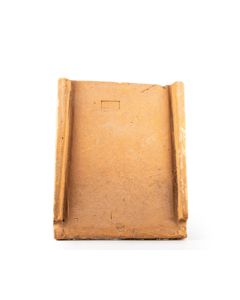 Large Roman legionary roof tile produced by Legio VI Victrix 70 - 104 A.D.
Large Roman legionary roof tile produced by Legio VI Victrix 70 - 104 A.D.Perfectly preserved, extremely rare for an object of this size. Found near the Roman city of Novaesium, today's Neuss in Germany, an early Roman foundation and with this one of the oldest cities in Germany.
€2,500 Roman artefacts from the Rhineland
Roman artefacts from the RhinelandFragments of Roman pottery vessels, bronze and glass fragment, as well as a piece of a mosaic. Finds from the Roman city of Novaesium, today's Neuss in Germany.
Price: on request Large Roman roof tile from the Rhineland
Large Roman roof tile from the RhinelandWith loop-shaped mark. Found near the Roman city of Novaesium, today's Neuss in Germany, an early Roman foundation and with this one of the oldest cities in Germany.
€740 Roman Terra Nigra beaker found 1907 in Cologne
Roman Terra Nigra beaker found 1907 in CologneFrom the collection of the viniculture historian Friedrich von Bassermann-Jordan. Nicely preserved.
Price: on request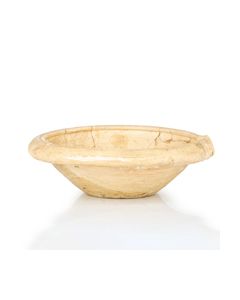 Very large Roman mortarium from the Rhineland
Very large Roman mortarium from the RhinelandDiameter 42 cm. Found near the Roman city of Novaesium, today's Neuss in Germany, an early Roman foundation and with this one of the oldest cities in Germany.
€1,470 Large Roman legionary roof tile produced by Legio VI Victrix 70 - 104 A.D.
Large Roman legionary roof tile produced by Legio VI Victrix 70 - 104 A.D.Perfectly preserved, extremely rare for an object of this size. Found near the Roman city of Novaesium, today's Neuss in Germany, an early Roman foundation and with this one of the oldest cities in Germany.
Price: on request Celtic spear head - found 1982 near Frome, Sommerset, UK
Celtic spear head - found 1982 near Frome, Sommerset, UKIron, about 2nd century BC - 1st century AD. With export permit by the Arts Council of England.
Price: on request Roman and medieval potsherds from the Rhineland
Roman and medieval potsherds from the RhinelandFragments of Roman and medieval pottery. Finds from the Roman city of Novaesium, today's Neuss in Germany, an early Roman foundation and with this one of the oldest cities in Germany.
Price: on request Roman potsherds from the Rhineland
Roman potsherds from the RhinelandFragments of Roman pottery. Finds from the Roman city of Novaesium, today's Neuss in Germany, an early Roman foundation and with this one of the oldest cities in Germany.
Price: on request Small Terra Sigillata bowl from the Rhineland
Small Terra Sigillata bowl from the RhinelandFound 1970 near the Roman city of Novaesium, today's Neuss in Germany. Novaesium was an early Roman foundation and with this is one of the oldest cities in Germany.
Price: on request Roman Terra Sigillata cup from the Rhineland
Roman Terra Sigillata cup from the RhinelandFound near the Roman city of Novaesium, today's Neuss in Germany, an early Roman foundation and with this one of the oldest cities in Germany.
Price: on request Roman Terra Sigillata cup from the Rhineland
Roman Terra Sigillata cup from the RhinelandFound near the Roman city of Novaesium, today's Neuss in Germany, an early Roman foundation and with this one of the oldest cities in Germany.
Price: on request Roman Terra Sigillata bowl with potters' mark OF PRIM from the Rhineland
Roman Terra Sigillata bowl with potters' mark OF PRIM from the RhinelandFound near the Roman city of Novaesium, today's Neuss in Germany, an early Roman foundation and with this one of the oldest cities in Germany.
Price: on request Large Terra Sigillata bowl from the Rhineland with running hare and hounds
Large Terra Sigillata bowl from the Rhineland with running hare and houndsFound near the Roman city of Novaesium, today's Neuss in Germany, an early Roman foundation and with this one of the oldest cities in Germany.
Price: on request Roman Terra Sigillata bowl - workshop of Memor - found in the Rhineland
Roman Terra Sigillata bowl - workshop of Memor - found in the RhinelandFound near the Roman city of Novaesium, today's Neuss in Germany, an early Roman foundation and with this one of the oldest cities in Germany.
Price: on request Roman Terra Sigillata bowl from the Rhineland
Roman Terra Sigillata bowl from the RhinelandFound near the Roman city of Novaesium, today's Neuss in Germany, an early Roman foundation and with this one of the oldest cities in Germany.
Price: on request Roman discus fibula with color glass paste
Roman discus fibula with color glass pasteSpannende Fibel mit Sterndekor und Glaspaste. Eine Weiterentwicklung keltischen Kunsthandwerks in der Zeit römischer Herrschaft. Gut dokumentierter Typ aus dem 2. Jh. v. Chr. mit Verbreitung in weiten Teilen Europas.
Price: on request Gallo-Roman animal fibula
Gallo-Roman animal fibulaZoomorphe Fibel mit Wildtier als Motiv. Schmuckstück mit religiöser Symbolik, vergleichbar einem Kreuzanhänger bei heutigen Christen. Gefertigt im 1. bis 3. Jh. n. Chr. in Gallien.
Price: on request Rare discus-shaped Celtic-Roman fibula
Rare discus-shaped Celtic-Roman fibulaAus der Entstehungszeit der plattenförmigen Fibeln, 1. Jh. n. Chr. Ästhetisch ansprechende Metallarbeit aus einer Fusion keltischer Handwerkstraditionen mit römischen Vorlieben.
Price: on request Enameled Galo-Roman fibula
Enameled Galo-Roman fibulaGrundform einer rechteckigen Platte, erweitert durch Zierknopf an Kopf- und Fußende. Drei Paare von Dreiecken auf der Platte sind durch weiße Einlagen hervorgehoben. Etwa 2. Jh. n. Chr.
Price: on request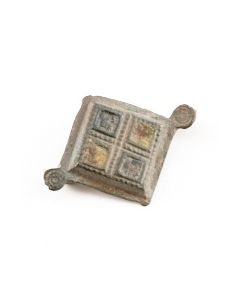 Impressively preserved enameled Roman brooch
Impressively preserved enameled Roman broochIn Britannien und Gallien produzierter Fibeltyp des zweiten Jahrhunderts. Edel patinierte Bronzeoberfläche. Besonders hervorzuheben ist die Emailauflage in selten gutem Erhaltungszustand.
Price: on request Large knife from early Bronze Age Europe
Large knife from early Bronze Age EuropeBeeindruckendes Bronzemesser mit elegant geschwungener Klinge. Besonders hervorzuheben ist der gut erhaltene Teller und Griffdorn. Hervorragende Erhaltung des Metalls.
Price: on request Spear end cap from Bronze Age Europe
Spear end cap from Bronze Age EuropeSeltenes Exemplar eines Speerfußes aus der europäischen Bronzezeit. Das Material ist in hervorragender Erhaltung und zeugt von der damiligen Ausrüstung eines Kriegers.
Price: on request Bronze socketed axe head from large collection
Bronze socketed axe head from large collectionSehr schönes Exemplar eines Bronzebeils vom Typ der sogenannten Tüllenbeile. Es stammt aus einer gut geführten Sammlung, die einen breiten Querschnitt europäischer Tüllenbeile abbildet.
Price: on request Roman oil lamp showing Victoria in biga - an identic lamp is on exhibition in the National Warsaw Museum
Roman oil lamp showing Victoria in biga - an identic lamp is on exhibition in the National Warsaw MuseumEine identische Lampe ist im Nationalmuseum von Warschau ausgestellt.
Price: on request Roman bronze oil lamp - found in the UK
Roman bronze oil lamp - found in the UKFund aus der Ostenglischen Grafschaft Norfolk. Dokumentiert im Rahmen der PAS (Portable Antiques Scheme). Museale Erhaltung mit edler Patina.
Price: on request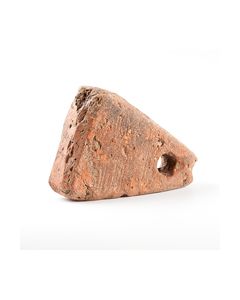 Roman clay loom weight
Roman clay loom weightMassives Gewicht aus Terrakotta mit Öse zur Aufhängung als Webgewicht, aus der römischen Kaiserzeit, Germanische Provinzen, 1. bis 2. Jh. n. Chr.
Price: on request Ancient clay weight from the northern provinces
Ancient clay weight from the northern provincesMassives Gewicht aus Terrakotta mit Längsbohrung zur Aufhängung, vermutlich aus römischer Zeit, Germanische Provinzen, 1. bis 4. Jh. n. Chr.
Price: on request Clay rattle shaped as a bird from the Lusatian culture
Clay rattle shaped as a bird from the Lusatian cultureRassel in Form eines Hauses. Aus dem Übergang der Späten Bronzezeit zur Frühen Eisenzeit Nordmittel-Europas. 1300 bis 500 v. Chr.
Price: on request Small bowl from the Lusatian culture
Small bowl from the Lusatian cultureKleines Schälchen aus grober Keramik. Möglicherweise Votivgabe oder Grabbeigabe für Kinder.
Price: on request Small flat bowl from the Lusatian culture
Small flat bowl from the Lusatian cultureKleines, flaches Trinkschälchen mit Henkel. Möglicherweise Votivgabe oder Grabbeigabe für Kinder. Museale Erhaltung, keine Schäden oder Risse.
Price: on request Small socketed axe head from the late Bronze Age
Small socketed axe head from the late Bronze AgeBronzezeitlicher Beilkopf mit vierkantigem Querschnitt. Schön erkennbarer Grat von der Herstellung in einer Gussform. Ringöse an der Seite. Späte Bronzezeit.
Price: on request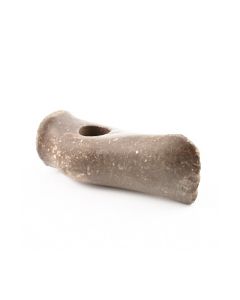 Neolithic hammer axe from Middle Europe
Neolithic hammer axe from Middle EuropeDer Axttyp ist mit seiner fließenden Form sehr elegant. Die fein ausgeführte Oberflächenbearbeitung ist bewundernswert. 2800 bis 2200 v. Chr., mitteleuropäisches Endneolithikum.
Price: on request Thin butted axe head from the Funnel Beaker culture
Thin butted axe head from the Funnel Beaker cultureDünnnackige Beilklinge aus grauem Flint mit schönen rot-braunen Einschlüssen. Dolmenzeit bis Ganggrabzeit. Beeindruckend durch die Größe.
Price: on request Battle axe from the late Neolithic
Battle axe from the late NeolithicDer eindrucksvolle Axtkopf ist grob bearbeitet, wie dies für die Einzelgrabkultur typisch ist. Sehr schöner alter Fund aus Norddeutschland. Etwa 3300 bis 2300 v. Chr.
Price: on request

